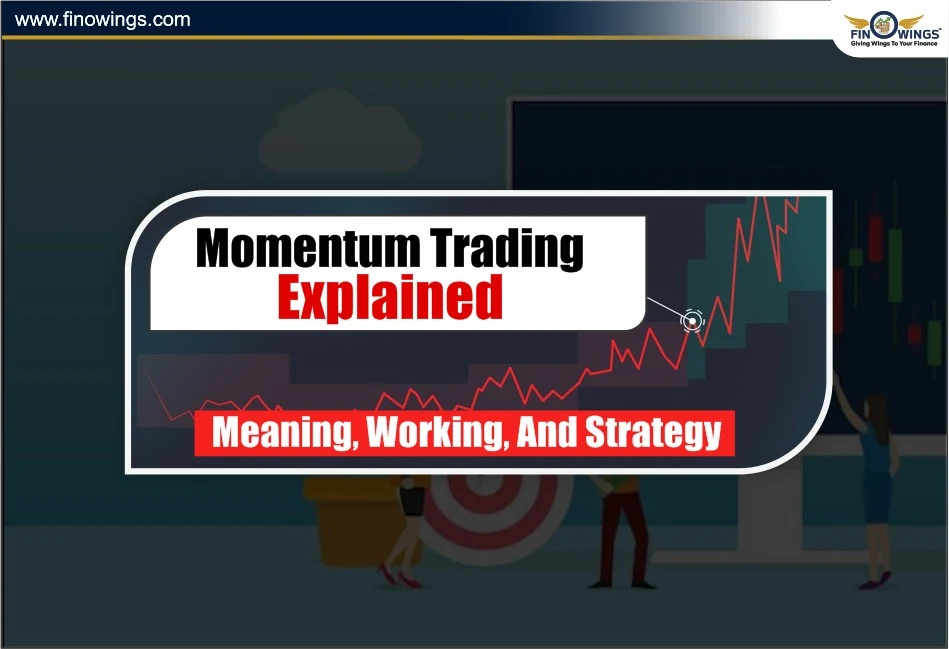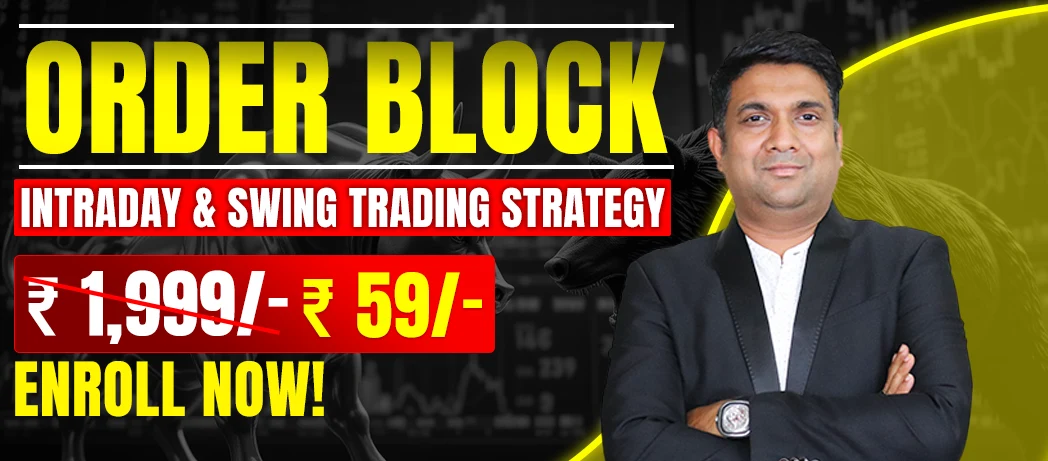Home >> Blog >> Momentum Trading Explained: Meaning, Working, and Strategy
Momentum Trading Explained: Meaning, Working, and Strategy

Table of Contents
- What Is Momentum Trading? (Momentum Trading Meaning)
- How Momentum Trading Works
- The Psychology Behind Momentum Trading
- Typical Trend Momentum Trading Indicators
- Top Momentum Trading Techniques
- Example of Momentum Trading in Action
- Effective Momentum Trading Tips
- Momentum Trading vs Value Investing
- Conclusion
In the world of trading, timing is critical. Traders continuously search for indications of whether a stock's price is likely to continue moving in the same direction. Momentum trading is a powerful and popular trading approach in such situations and is widely utilised by both professionals and retail investors.
In the following sections of this guide, we will analyse momentum trading meaning, its workings, and the best momentum trading strategies to help you improve your market moves.
What Is Momentum Trading? (Momentum Trading Meaning)
The goal of momentum trading, a short- to medium-term trading strategy, is to profit on an established trend's strength. The fundamental tenet of momentum trading is that "what goes up, keeps going up - until it doesn't."
Traders buy stocks that are rising and sell them when momentum slows down or reverses. Similarly, they short-sell declining stocks, expecting the fall to continue.
Example:
When a stock rises from ₹200 to ₹230 in a single day and has strong volume, a momentum trader would buy the stock in anticipation that the stock price would rise to ₹250–₹260.
How Momentum Trading Works
The essence of momentum trading is spotting and riding strong trends in price movements.
Here’s a sequential guide to help you understand step by step:
1. Spot a Strong Trend: Traders try to find stocks that have strong price momentum by using the Relative Strength Index (RSI), Moving Averages and MACD.
2. Check Volume: A price increase accompanied by higher than average volume confirms that the trend has momentum.
3. Execute the Trade: Traders execute a trend-following strategy once the price surpasses a significant resistance level, such as a major moving average.
4. Ride the Trend: Momentum traders remain in the trade as long as the momentum pushes the price in the expected direction.
5. Exit with Discipline: Momentum traders exit a trade through predetermined stop-loss levels, or they wait for momentum indicators to signal the trade’s exhaustion.
The effectiveness of momentum trading strategies relies primarily on discipline, emotional restraint, technical prowess, and emotional stability.
The Psychology Behind Momentum Trading
-
Markets are influenced by the emotions of the participants. Momentum trading capitalises on the emotions of the market participants.
-
The higher the price the more traders purchase and this makes the price increase even more.
-
The fear of losing more pushes people to sell faster and faster forming a snowball effect when the prices drop.
-
This cycle persists in the same manner until a change in sentiment occurs.
-
Recognising this type of psychology helps traders to ride the wave instead of fighting it.
Typical Trend Momentum Trading Indicators
Below are the most frequently applied for momentum trading strategy:
|
Indicator |
Purpose |
What It Shows |
|
RSI (Relative Strength Index) |
Measures speed and change of price movement |
Overbought (70+) or Oversold (30-) zones |
|
MACD (Moving Average Convergence Divergence) |
Identifies trend direction and strength |
Crossovers = entry/exit signals |
|
Moving Averages (20, 50, 200-day) |
Smooth out price data |
Trend confirmation |
|
Volume Analysis |
Confirms price strength |
High volume = stronger trend |
|
Rate of Change (ROC) |
Measures how fast prices change |
Detects acceleration or slowdown |
The use of more than one of these indicators helps a trader understand the trend more completely and spot possible reversals more easily.
Top Momentum Trading Techniques
Having understood the variable for what momentum trading is, let's review the best momentum trading strategies utilised by traders around the world.
1. Moving Average Crossover Strategy
-
Two moving averages are employed by one trader, that is, a short-term and a long-term moving average (e.g., 20-day and 50-day).
-
An entry that is bullish is the formation of a Golden Cross (when short-term MA crosses long-term MA).
-
The formation of a Death Cross (where the short-term MA falls below the long-term MA) is an exit for the trade or a short opportunity.
-
This is one of the most straightforward and dependable momentum trading strategies.
2. Breakout Trading Strategy
Traders identify stocks that break above levels of resistance or break below levels of support.
The ability to breakout combined with considerable volume confirms the strength of the underlying momentum.
Example
A stock breaking ₹500 resistance with 3x volume often signals strong upward momentum.
3. RSI + MACD Combination Strategy
-
Traders combine both indicators to further signal confirmation.
-
RSI breaking above 50 and MACD crossing shows bullish momentum.
-
RSI getting close to 70, the overbought level, or MACD showing bearish divergence, is the exit signal.
4. High Volume Stock Screening Strategy
-
Volume spikes, especially when unusual, is a stock trading signal and momentum indicator.
-
This method aims to catch the early stage of a buying or selling spree.
-
Tools/software used to find such setups include TradeView, Zerodha Streak, and ChartInk, to name a few.
Example of Momentum Trading in Action
Think of the case of Infosys shares. The price is ₹1,450.
You see the RSI is 60, and the 20-day moving average has crossed above the 50-day average. Volume has increased 60% from last week. There has been and is strong buying momentum. You go long and buy at 1,455. The target is approximately 1,520, and your stop-loss is 1,420. When the RSI reaches 70, a sign that momentum has diminished, you close the position and profit.
Benefits of Momentum Trading
-
Rapid Gains: During times when the market is highly active and making large moves, they can earn money very quickly.
-
Clear Signals: It is straightforward and based on definitive metrics.
-
Minimal Time Involvement: They work best for day traders and those making short-term trades.
-
Diverse: It can be employed on stocks, currencies, or any kind of trading commodity.
Potential Risks
-
Unreliable Signals: Not every signal made within the active trading framework is valid.
-
Extreme Risk: Fast market moves can cause large losses.
-
Emotional Control Needed: Trading based on emotions can be highly profitable, but is effectively dangerous.
-
Cost of Trading: More frequent trading increases your commission costs.
Effective Momentum Trading Tips
1. Target active stocks that have lots of buying and selling.
2. Use stop-loss orders to limit losses.
3. Don’t trade too much - focus on 2-3 profitable setups per week.
4. Use multiple technical factors to ensure a signal.
5. Monitor market trends and be aware of sudden market changes.
Momentum Trading vs Value Investing
|
Aspect |
Momentum Trading |
Value Investing |
|
Time Horizon |
Short to Medium Term |
Long Term |
|
Approach |
Price-driven |
Fundamentals-driven |
|
Goal |
Quick profit from trends |
Wealth building over years |
|
Tools Used |
RSI, MACD, Moving Averages |
Balance Sheet, PE Ratio, EPS |
Momentum trading centres on “price action” while value investing centres on “intrinsic value.”
Conclusion
Momentum trading is one of the most powerful techniques for active traders who thrive on price action and volatility. It assists you in taking gains when the market is making short-term movements and correlating trades with the market sentiment. Nevertheless, like in any strategy, it demands discipline, emotional control and good risk management.
Should you wish to use these momentum trading strategies, then you should open small trades to test your setups and manage your trading psychology. This is the path that successful traders take.
Don't miss our comprehensive Guide to Options and Futures Trading in India if you want to learn more about trading. We go over how derivative markets operate, important tactics, and how traders use futures and options to hedge and boost returns in addition to momentum trading setups.
DISCLAIMER: This blog is NOT any buy or sell recommendation. No investment or trading advice is given. The content is purely for educational and information purposes only. Always consult your eligible financial advisor for investment-related decisions.
Author
Frequently Asked Questions
Momentum trading is a strategy where traders buy stocks that are rising and sell those that are falling, aiming to profit from continued price trends. The idea is that strong momentum in price movement often continues for a short period.
The most popular momentum trading indicators are:
-
RSI (Relative Strength Index)
-
MACD (Moving Average Convergence Divergence)
-
Moving Averages (20, 50, 200-day)
-
Volume Analysis
-
Rate of Change (ROC)
These help traders identify strong trends and possible entry or exit points.
Momentum trading can be profitable but risky for beginners. It requires a good understanding of technical indicators and quick decision-making. New traders should start with paper trading or small positions before using real money.
Momentum trading involves high volatility, false signals, and emotional stress. Sudden price reversals can lead to significant losses, especially without proper stop-loss orders. Frequent trading can also increase brokerage costs.
To find momentum stocks in India, traders use stock screeners like ChartInk, Zerodha Streak, or TradingView. They look for stocks with:
-
Rising price and high volume
-
RSI above 50
-
Moving average crossover (like 20-day crossing 50-day)
These signals often indicate strong ongoing momentum.




.webp)














